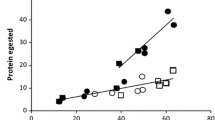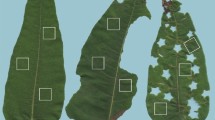Abstract
First-instar larvae of the monarch butterfly, Danaus plexippus, a milkweed specialist, generally grew faster and survived better on leaves when latex flow was reduced by partial severance of the leaf petiole. The outcome depended on milkweed species and was related to the amount of latex produced. The outcome also may be related to the amount of cardenolide produced by the plants as a potential chemical defense against herbivory. Growth was more rapid, but survival was similar on partially severed compared with intact leaves of the high-latex/low-cardenolide milkweed, Asclepias syriaca, whereas both growth and survival were unaffected on the low-latex/low-cardenolide milkweed A. incarnata. On the low-latex/low-cardenolide milkweed A. tuberosa, both growth and survival of larvae were only marginally affected. These results contrast sharply to previous results with the milkweed, A. humistrata, in Florida, which has both high latex and high cardenolide. Larval growth and survival on A. humistrata were both increased by partially severing leaf petioles. Larval growth rates among all four milkweed species on leaves with partially severed petioles were identical, suggesting that latex and possibly the included cardenolides are important in first-instar monarch larval growth, development, and survivorship.
Similar content being viewed by others
REFERENCES
Ackery, P. R., and Vane-Wright, R. I. 1984. Milkweed Butterflies: Their Cladistics and Biology. Cornell University Press, Ithaca, New York.
Baldwin, I. T. 1989. Mechanism of damage-induced alkaloid production in wild tobacco. J. Chem. Ecol. 15:1661-1680.
Baldwin, I. T. 1991. Damage-induced alkaloids in wild tobacco, pp. 47-69, in D. W. Tallamy and M. J. Raupp (eds.). Phytochemical Induction by Herbivores. John Wiley & Sons, New York.
Baldwin, I. T., and Ohnmeiss, J. T. 1994. Coordination of photosynthetic and alkaloidal responses to damage in uninducible and inducible Nicotiana sylvestris. Ecology 75(4):1003-1004.
Baldwin, I. T., Karb, M. J., and Ohnmeiss, T. E. 1994a. Allocation of 15N from nitrate to nicotine: Production and turnover of a damage-induced mobile defense. Ecology 75(6):1703-1713.
Baldwin, I. T., Schmelz, E. A., and Ohnmeiss, T. E. 1994b. Wound-induced changes in root and shoot jasmonic acid pools correlate with induced nicotine synthesis in Nicotiana sylvestris Spegazzini and Comes. J. Chem. Ecol. 20(8):2139-2157.
Berenbaum, M. 1981. Effects of linear furanocoumarins on an adapted specialist insect (Papilio polyxenes). Ecol. Entomol. 6:345-351.
Bhowmik, P. C., and Bandeen, J. D. 1976. The biology of Canadian weeds 19. Asclepias syriaca L. Can. J. Plant Sci. 56:579-589.
Brewer, J. 1977. Short lived phenomena. News Lepid. Soc. 4:7.
Brower, L. P. 1961. Studies on the migration of the monarch butterfly I. Breeding populations of Danaus plexippus and D. gilippus berenice in south central Florida. Ecology 42(1):76-83.
Brower, L. P. 1984. Chemical defensse in butterflies. Symp. R. Entomol. Soc. London 11:109-134.
Brower, L. P., Nelson, C. J., Seiber, J. N., Fink, L. S., and Bond, C. 1988. Exaptation as an alternative to co-evolution in the cardenolide-based chemical defense of monarch butterflies (Danaus plexippus L.) against avian predators, pp. 447-475, in K. C. Spencer (ed.). Chemical Mediation of Coevolution. Academic Press, San Diego.
Cohen, J. A., and Brower, L. P. 1982. Oviposition and larval success of wild monarch butterflies (Lepidoptera: Danaidae) in relation to host size and cardenolide concentration. J. Kans. Entomol. Soc. 55:343-348.
Dempster, J. P. 1983. The natural control of populations of butterflies and moths. Biol. Rev. 58:461-481.
Dixon, C. A., Erikson, J. M., Kellet, D. N., and Rothschild, M. 1978. Some adaptations between Danaus plexippus and its food plant, with notes on Danaus chrysippus and Euploea core (Insecta: Lepidoptera). J. Zool. London 185:437-467.
Dussourd, D. E. 1990. The vein drain: or how insects outsmart plants. Nat. Hist. 90:44-49.
Dussourd, D. E. 1993. Foraging with Finesse: Caterpillar adaptations for circumventing plant defenses, pp. 93-131, in N. E. Stamp and T. M. Casey (eds.). Caterpillars. Ecological and Evolutionary Constraints on Foraging. Chapman & Hall, New York.
Dussourd, D. E., and Eisner, T. 1987. Vein-cutting behaviour: Insect counterploy to the latex defense of plants. Science 237:898-901.
Feeny, P. 1976. Plant apparency and chemical defense. Recent Adv. Phytochem. 10:1-40.
Gould, F. 1988. Genetics of pairwise and multispecies plant-herbivore coevolution, pp. 13-55, in K. C. Spencer (ed.). Chemical Mediation of Coevolution. Academic Press, San Diego.
Horisberger, J.-D. 1994. The NaK-ATPase: Structure-function relationship. R. G. Landes Company, Austin, Texas.
Karban, R. 1991. Inducible resistance in agricultural systems, pp. 403-419, in D. W. Tallamy and M. J. Raupp (eds.). Phytochemical Induction by Herbivores. John Wiley & Sons, New York.
Karban, R., and Adler, F. R. 1996. Induced resistance to herbivores and the information content of early season attack. Oecologia 107:379-385.
Karban, R., and Niiho, C. 1995. Induced resistance and susceptibility to herbivory: Plant memory and altered plant development. Ecology 76(4):1220-1225.
Kyi, A., Zalucki, M. P., and Titmarsh, I. J. 1991. Factors affecting the survival of the early stages of Heliothis armigera (Hubner) (Lepidoptera: Noctuidae). Bull. Entomol. Res. 81:263-271.
Lucansky, T. W., and Cloug, K. T. 1986. Comparative anatomy and morphology of Asclepias perennis and A. tuberosa subspecies rolfsii. Bot. Gaz. 147:290-301.
Malcolm, S. B. 1991. Cardenolide-mediated interactions between plants and herbivores, pp. 251-296, in G. A. Rosenthal and M. R. Berenbaum (eds.). Herbivores: Their Interactions with Secondary Plant Metabolites, Second Edition. Volume I: The Chemical Participants. Academic Press, San Diego.
Malcolm, S. B. 1995. Milkweeds, monarch butterflies and the ecological significance of cardenolides. Chemoecology 5/6:101-117.
Malcolm, S. B., and Brower, L. P. 1986. Selective oviposition by monarch butterflies (Danaus plexippus L.) in a mixed stand of Asclepias curassavica L. and A. incarnata L. in south Florida. J. Lepid. Soc. 40:255-263.
Malcolm, S. B., and Brower, L. P. 1989. Evolutionary and ecological implications of cardenolide sequestration in the monarch butterfly. Experientia 45:284-295.
Malcolm, S. B., and Zalucki, M. P. 1996. Milkweed latex and cardenolide induction may resolve the lethal plant defense paradox. Entomol. Exp. Appl. 80:193-196.
Malcolm, S. B., Cockrell, B. J., and Brower, L. P. 1989. Cardenolide fingerprint of monarch butterflies reared on the common milkweed, Asclepias syriaca L. J. Chem. Ecol. 15:819-853.
Malcolm, S. B., Cockrell, B. J., and Brower, L. P. 1993. Spring recolonization of eastern North America by the monarch butterfly: Successive brood or single sweep migration? pp. 253-267, in S. B. Malcolm and M. P. Zalucki (eds.). Biology and Conservation of the Monarch Butterfly. Natural History Museum of Los Angeles County Science Series No. 38, Los Angeles.
McCloud, E. S., Tallamy, D. W., and Halaweish, F. T. 1995. Squash beetle trenching behaviour: Avoidance of cucurbitacin induction or mucilaginous plant sap? Ecol. Entomol. 20:51-59.
Nelson, C. J. 1993. Sequestration and storage of cardenolides and cardenolide glycosides by Danaus plexippus L. and D. chrysippus petilia (Stoll) when reared on Asclepias fruticosa L.; a review of some factors that influence sequestration, pp. 91-105, in S. B. Malcolm and M. P. Zalucki (eds.). Biology and Conservation of the Monarch Butterfly. Natural History Museum of Los Angeles County Science Series No. 38, Los Angeles.
Nelson, C. J., Seiber, J. N., and Brower, L. P. 1981. Seasonal and intraplant variation of cardenolide content in the California milkweed, Asclepias eriocarpa, and implications for plant defense. J. Chem. Ecol. 7:981-1010.
Oyeyele, S., and Zalucki, M. P. 1990. Cardiac glycosides and oviposition by Danaus plexippus on Asclepias fruticosa in south-east Queensland (Australia), with notes on the effects of plant nitrogen. Ecol. Entomol. 15:177-185.
Petricic, J. 1966. Über die cardenolide der wurzeln von Asclepias tuberosa L. Arch. Pharm. 299:1007-1011.
Polowick, P. L., and Raju, M. V. S. 1982. The origin and development of root buds in Asclepias syriaca. Can. J. Bot. 60:2119-2125.
Rhoades, D. F., and Cates, R. G. 1976. Toward a general theory of plant antiherbivore chemistry. Recent Adv. Phytochem. 10:168-213.
Roeske, C. N., Seiber, J. N., Brower, L. P., and Moffitt, C. M. 1976. Milkweed cardenolides and their comparative processing by monarch butterflies (Danaus plexippus L.). Recent Adv. Phytochem. 10:168-213.
Rothschild, M. 1977. The cat-like caterpillar. News Lepid. Soc. 6:9.
Scriber, J. M. 1984. Host-plant suitability, pp. 159-202, in W. J. Bell and R. T. Cardé (eds.). Chemical Ecology of Insects. Chapman and Hall, London.
Seiber, J. N., Nelson, C. J., and Lee, S. M. 1982. Cardenolides in the latex and leaves of seven Asclepias species and Calotropis procera. Phytochemistry 21:2343-2348.
Tallamy, D. W., and McCloud, E. S. 1991. Squash beetles, cucumber beetles, and inducible cucurbit responses, pp. 155-181, in D. W. Tallamy and M. J. Raupp (eds.). Phytochemical Induction by Herbivores. John Wiley & Sons, New York.
Van Emon, J. V., and Seiber, J. N. 1985. Chemical constituents and energy content of two milkweeds, Asclepias speciosa and A. curassavica. Econ. Bot. 39:47-55.
Van Hook, T., and Zalucki, M. P. 1991. Oviposition by Danaus plexippus on Asclepias viridis in northern Florida. J. Lepid. Soc. 45:215-221.
Wilson, K. J., and Mahlberg, P. G. 1980. Ultrastructure of developing and mature nonarticulated laticifers in the milkweed, Asclepias syriaca L. (Asclepiadaceae). Am. J. Bot. 67:1160-1170.
Woodson, R. E., Jr. 1954. The North American species of Asclepias L. Ann. Miss. Bot. Gard. 41:1-211.
Zalucki, M. P. 1982. Temperature and rate of development in Danus plexippus L. and D. chrysippus L. (Lepidoptera: Nymphalidae). J. Aust. Entomol. Soc. 21:241-246.
Zalucki, M. P., and Brower, L. P. 1992. Survival of first instar larvae of Danaus plexippus (Lepidoptera: Danainae) in relation to cardiac glycoside and latex content of Asclepias humistrata (Asclepiadaceae). Chemoecology 3:81-93.
Zalucki, M. P., and Kitching, R. L. 1982a. Temporal and spatial variation of mortality in field populations of Danaus plexippus L. and D. chrysippus L. larvae. Oecologia 53:201-207.
Zalucki, M. P., and Kitching, R. L. 1982b. Dynamics of oviposition in Danaus plexippus (Insecta: Lepidoptera) on milkweed, Asclepias spp. J. Zool. 198:103-116.
Zalucki, M. P., Oyeyele, S., and Vowles, P. 1989. Selective oviposition by Danaus plexippus L. (Lepidoptera: Nymphalidae) in a mixed stand of Asclepias fruticosa and A. curassavica in southeast Queensland. J. Aust. Entomol. Soc. 28:141-146.
Zalucki, M. P., Brower, L. P., and Malcolm, S. B. 1990. Oviposition by Danaus plexippus in relation to cardenolide content of three Asclepias species in the southeastern U.S.A. Ecol. Entomol. 15:231-240.
Author information
Authors and Affiliations
Rights and permissions
About this article
Cite this article
Zalucki, M.P., Malcolm, S.B. Plant Latex and First-Instar Monarch Larval Growth and Survival on Three North American Milkweed Species. J Chem Ecol 25, 1827–1842 (1999). https://doi.org/10.1023/A:1020929732223
Issue Date:
DOI: https://doi.org/10.1023/A:1020929732223




